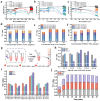Europium Nanoparticle-Based Lateral Flow Strip Biosensors for the Detection of Quinoxaline Antibiotics and Their Main Metabolites in Fish Feeds and Tissues
- PMID: 38920596
- PMCID: PMC11202277
- DOI: 10.3390/bios14060292
Europium Nanoparticle-Based Lateral Flow Strip Biosensors for the Detection of Quinoxaline Antibiotics and Their Main Metabolites in Fish Feeds and Tissues
Abstract
Olaquindox (OLA) and quinocetone (QCT) have been prohibited in aquatic products due to their significant toxicity and side effects. In this study, rapid and visual europium nanoparticle (EuNP)-based lateral flow strip biosensors (LFSBs) were developed for the simultaneous quantitative detection of OLA, QCT, and 3-methyl-quinoxaline-2-carboxylic acid (MQCA) in fish feed and tissue. The EuNP-LFSBs enabled sensitive detection for OLA, QCT, and MQCA with a limit of detection of 0.067, 0.017, and 0.099 ng/mL (R2 ≥ 0.9776) within 10 min. The average recovery of the EuNP-LFSBs was 95.13%, and relative standard deviations were below 9.38%. The method was verified by high-performance liquid chromatography (HPLC), and the test results were consistent. Therefore, the proposed LFSBs serve as a powerful tool to monitor quinoxalines in fish feeds and their residues in fish tissues.
Keywords: fluorescent nanomaterials; lateral flow strip biosensors; multiple detection; quinoxaline antibiotics.
Conflict of interest statement
The authors declare no conflict of interest, and also declare no competing financial interests.
Figures




Similar articles
-
Europium Nanoparticle-Based Lateral Flow Strip Biosensors Combined with Recombinase Polymerase Amplification for Simultaneous Detection of Five Zoonotic Foodborne Pathogens.Biosensors (Basel). 2023 Jun 14;13(6):652. doi: 10.3390/bios13060652. Biosensors (Basel). 2023. PMID: 37367017 Free PMC article.
-
Simultaneous determination of five quinoxaline-1,4-dioxides in animal feeds using an immunochromatographic strip.Food Addit Contam Part A Chem Anal Control Expo Risk Assess. 2016;33(2):244-51. doi: 10.1080/19440049.2015.1124461. Epub 2015 Dec 23. Food Addit Contam Part A Chem Anal Control Expo Risk Assess. 2016. PMID: 26666867
-
Development of a high-performance liquid chromatography method for the simultaneous quantification of quinoxaline-2-carboxylic acid and methyl-3-quinoxaline-2-carboxylic acid in animal tissues.J Chromatogr A. 2007 Mar 30;1146(1):1-7. doi: 10.1016/j.chroma.2006.11.024. Epub 2007 Mar 1. J Chromatogr A. 2007. PMID: 17335836
-
Lateral Flow Strip Biosensors for Foodborne Pathogenic Bacteria via Direct and Indirect Sensing Strategies: A Review.J Agric Food Chem. 2023 Jul 12;71(27):10250-10268. doi: 10.1021/acs.jafc.3c02094. Epub 2023 Jun 30. J Agric Food Chem. 2023. PMID: 37389539 Review.
-
Aptasensors as the future of antibiotics test kits-a case study of the aptamer application in the chloramphenicol detection.Biosens Bioelectron. 2018 Dec 30;122:263-283. doi: 10.1016/j.bios.2018.09.060. Epub 2018 Sep 18. Biosens Bioelectron. 2018. PMID: 30268964 Review.
References
-
- Zhang Y., Zhou S., Chang X., Tao X. Development of a sensitive chemiluminescent immunoassay for the determination of 3-methyl-quinoxaline-2-carboxylic acid and quinoxaline-2-carboxylic acid in edible animal tissues using immunomagnetic beads capturing. Anal. Sci. 2019;35:1291–1293. doi: 10.2116/analsci.19C009. - DOI - PubMed
-
- Qiu M., Liu C., Tang Q., Zhang Y., Wang H., Zhai B., Xu K., Zhou Y., Qu L., Li Q., et al. Distribution and elimination of quinocetone and its major metabolites in Cherry Valley ducks. J. Vet. Pharmacol. Ther. 2019 online ahead of print . - PubMed
MeSH terms
Substances
Grants and funding
LinkOut - more resources
Full Text Sources
Medical

